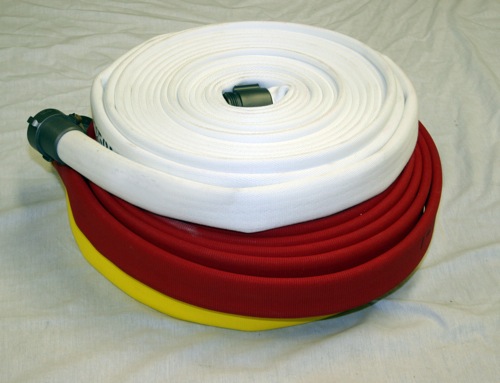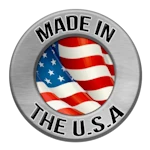At Rawhide Fire Hose, we’re proud to support firefighters around the world with the fire hose products and accessories they need to keep people safe. There are many different types of firehoses for many different fire applications. Whether you’re battling a Class A fire, containing a wildfire, responding to a flash fire emergency, or performing a mop-up on a smoldering fire, we have the right hoses to take care of the fire.
What is a Fire Hose Made Of?
Today, most fire hoses are made of a nitrile rubber tube that is insulated by a woven polyester fabric jacket instead of the cotton fire hose canvas used in the past. However, fire hose can be classified in different ways based on such criteria as fire hose material, thickness and method of construction. At Rawhide Fire Hose, we offer several types of fire hoses for a variety of applications.
Understanding Fire Categories and Their Applications
Class A Fires
Class A Fires are fueled by combustible materials such as wood, cloth, paper, rubber and plastics.
Wildfires
Wildfires occur in forests, grasslands, and rural areas. Due to the remote locations, they require portable, lightweight fire hose equipment.
Flash Fires
Typically, it occurs in industrial or enclosed environments where flammable gases ignite quickly.
Smoldering Fires
These fires burn slow and produce heavy smoke that are found in hard to reach or hidden places.
What are the Different Types of Fire Hoses?
Single Jacket Fire Hose
Single jacket fire hoses have only a single layer of spun polyester fabric encasing the internal rubber hose. This type of fire hose is better suited for periodic or temporary use, and long-term storage. This is typically the most economical option of the three basic fire hose types. These types of hoses are most used for applications that are occasional, light use and don’t require high-pressure.
Double Jacket Fire Hose
Double jacket fire hoses have two layers of spun polyester fabric, with one layer on the outside. You should use a double jacket fire hose when you need a durable hose that can withstand higher pressures and prolonged. For Class A fires, this hose is preferred.
Rubber-covered Fire Hose
The rubber covered fire hose is built to resist ozone, oxidation, and most chemical/petroleum products. The nitrile rubber tube is covered with a 100% synthetic yarn reinforcement that’s designed with “through-the-weave” construction to ensure the fire hose will not divide when exposed to fuels, oil, and most low concentrated chemicals.
These hose types can be combined to create hoses for specific functions.
Forestry Fire Hoses
Forestry fire hoses are lightweight, durable, and offer maneuverability. They are designed for extinguishing wildfires.
Supply Line Fire Hose vs. Booster Fire Hose
In a fire, hoses are used as either supply lines or booster lines. Keep reading to discover the difference between supply line fire hose and booster fire hose.
Supply Line Fire Hose
Supply lines are fire hoses that deliver the main water supply, and are typically at least 3 inches in inside diameter, and may be as much as 6 inches. The supply line fire hoes are often called intake lines.
Supply line fire hoses must be constructed of fabric capable of holding enormous pressure, but flexibility is less important because the delivery of the water to the fire is done by the booster fire hose, or attack line. For this reason, supply hoses are always reinforced with multiple layers of firehose fabric capable of resisting great pressure, and sometimes that material has little flexibility.
Large diameter hose (LDH) are a popular choice for supply lines due to their ability to withstand big-flow even with low pressure. These LDH fire hoses are able to transport larger quantities of water over longer distances with less friction loss than a smaller diameter hose.
Booster Fire Hose
Booster fire hoses are perfect solution for smoldering fires. They branch off and deliver a single stream of water handled by one person or a team. Booster lines are usually 1-3/4” or 2-1/2” and are often referred to as attack lines.
Best Fire Hose Fabric for Different Jobs
Non-collapsible (rigid) supply line fire hoses have a rubber lining, layers of fabric and sometimes wire mesh reinforcement and an outer layer of rubber. For added flexibility, some types of hose use plastic mesh material instead of wire. Additional strength, heat resistance and pressure capacity can be gained by using fire hose material impregnated with polymer reinforcers. Since these additives cause changes in the hose’s flexibility, the types of fire hose are called “hard” or “soft.”
Each has its good points in the field. Woven fabric, or impregnated, fire hoses are soft and relatively easy to handle, so they lend themselves to repeated use and quick deployment. Hard fire hoses offer the advantage of non-collapsibility, necessary in places where the water supply is not pressurized.
There are a variety of different fire hose types for specific instances. Industrial mine hoses are suited for underground mining operations and are engineered using a single jacket exterior woven from polyester to reduce weight and increase flexibility, while resisting gravitational pressure and hydrolysis of the hose. Whereas marine washdown hoses are suited for rough outdoor conditions with frequent exposure to raw, fresh and salt water on ships or offshore facilities. Industry specific hoses can ensure that you are best prepared to handle any situation.
Best Fire Hose Type Based on Water Source
When a fire happens in an urban location, municipal water is available at standard pressure. Here, municipal fire hose made of a soft fabric can be used because the water will be at full pressure from the instant it leaves the supply valve.
If a fire happens in a rural location, the most abundant source of water may be a lake or river. For these situations you may want to consider a forestry fire hose that is made to resist the abrasive, irregular terrain in those areas. Firefighters can put a hose in the lake and pump water out, but if they try it with a collapsible hose, the natural pressure above the hose will make it collapse. Here, a non-collapsible fabric firehose is needed so it will keep its shape when lowered into the water.
Fire Hoses Built for Your Specific Application
If you’re looking for fire hoses for a specific application, contact us today. Rawhide Fire Hose has everything you need!


